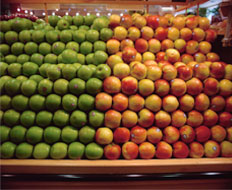Q: A Whole Foods just opened a block down the street. Should I be worried?
A: Yes! While a nearby Whole Foods is likely to draw traffic and attract higher-income customers to your area, it's also likely to steal sales from your restaurant. People now perceive grocery stores, including Whole Foods, Trader Joe's, and even standard chains like Kroger and Safeway, as more convenient, more affordable, and higher quality than quick-serve restaurants.
Foodservice at grocery stores has come a long way from the simple deli counters intended for meal-replacement purchases. Grocers are now applying service and marketing approaches that were once the sole purview of restaurants, including offering free WiFi, comfortable seating areas, cooking demos, and more. As a result, they pose a competitive threat to our industry. According to Technomic, the retailer meal solutions segment grew to $37 billion in sales in 2012, and its growth is expected to outpace that of restaurants and bars at least through 2014. So perhaps it’s time for us to take a closer look at what is driving grocery stores’ foodservice growth and to see which of those strategies and tactics might work in our category.
Of course, grocery stores enjoy some advantages that most quick serves can’t address. They carry a wide selection of options that translate into higher visit frequency and lower likelihood of a veto from a single picky person in a group that’s looking for a place to eat together. Consumers also can combine dining and shopping occasions at grocery stores, so there’s the convenience factor. But they use several marketing and customer experience approaches that are worth considering.
First, there’s what Forbes magazine once referred to as “food porn.” The article described how Whole Foods presented its food as “sensual, succulent succor,” using a theatrical approach to its product displays. Giant display cases present its food offerings artfully, and tantalizing aromas emanate from its food-preparation stations. Contrast how Whole Foods makes the product the star of the customer experience by shining a bright spotlight on its food, literally and figuratively, with how quick serves typically keep food hidden behind counters and in opaque packages.
Many grocery stores offer multiple service options. They have a grab-and-go section with pre-packaged options, usually located near the self-checkout stations. They also have counter service, where customers can place orders from a menu or request a custom order. And some even have multiple service counters for entrées, sides, salads, and drinks. Offering a similar array of choices could make fast-food restaurants more convenient and more appropriate for more dining occasions.
The employees at Trader Joe’s are that chain’s best marketing tool. They’re knowledgeable about the products, so they can answer questions about what ingredients are included or how an item tastes. They’re also friendly and engage with customers authentically, not robotically, following a script, or rushing customers through the line. Unfortunately, the same can’t be said about most employees who work at fast-food restaurants. Instead of hiring and training employees for requisite skills, we should ensure they are brand ambassadors in every customer transaction.
Safeway uses personalization and mobile customer targeting to stand out and develop more valuable relationships with its customers. Its “just for U” program is more than your standard loyalty program. Through analysis of past purchases, it serves up personalized deals to customers online, via direct mail, and through mobile phones. Quick serves have access to the same kind of data and technology, so it’s a wonder why more don’t take advantage of them.
While most of the marketing communications from quick serves rely on listing product ingredients and price points, grocery stores use storytelling to promote their offerings. The Fearless Flyer that’s mailed to Trader Joe’s customers and is available free in the store reads like those old J. Peterman catalogs. They romance the food with stories of its origins, as well as recipes and suggested uses. Whole Foods and Central Market use in-store signage and online blogs to convey the narratives behind their products. These brands know that sharing about the sources of food items, special preparation techniques, and reasons why they choose to offer certain items inspires people’s imaginations, differentiates their offerings, and forms a more emotional connection with customers.
Whole Foods is leading the movement among retail and restaurants to less chain-y, more community-oriented brands. In order to compete with independents and smaller chains that often enjoy cult-like followings, many national brands are favoring approaches that emphasize the individuality of each of their locations. Whole Foods excels at this by using local sourcing, promoting community events, and engaging local influencers like bloggers and community leaders in its promotions. Fast feeders may be reluctant to adopt such an approach for fear of detracting from the standards that customers expect from a restaurant chain, but Whole Foods demonstrates that some freedom within a strong framework actually increases a brand’s appeal.
By adapting the best practices at grocery stores, quick serves can more effectively compete with them. There’s also the “if you can’t beat ’em, join ’em” option. Fast feeders may want to consider partnering with grocery chains to operate locations inside the stores, as Genji Sushi does at Whole Foods and Wolfgang Puck Express at Gelson’s.




